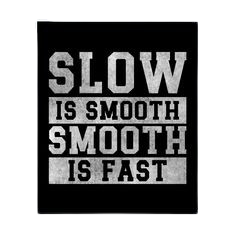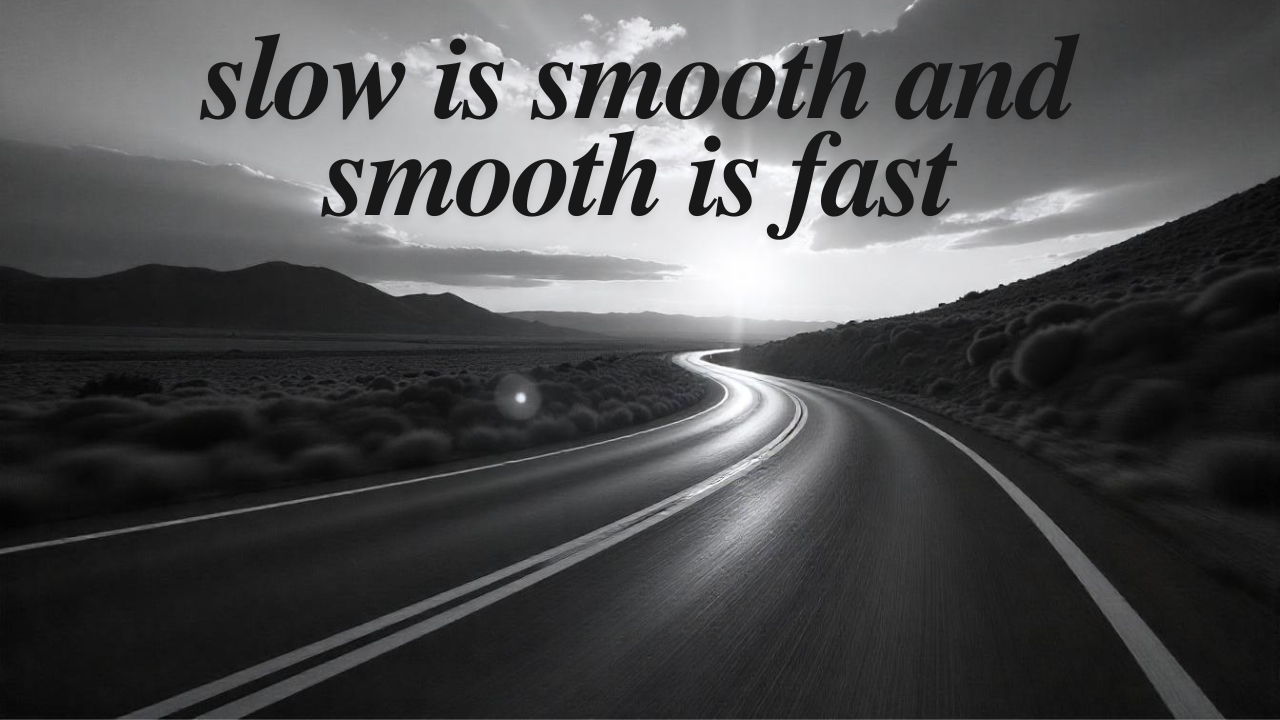In a world obsessed with speed, the phrase “slow is smooth and smooth is fast” might seem counterintuitive. Yet, this profound philosophy has roots in ancient wisdom and modern psychology, teaching us that deliberate, focused action often leads to greater efficiency and success than hurried efforts. By embracing this mindset, we can transform the way we approach challenges in our personal and professional lives.
Introduction to “Slow is Smooth and Smooth is Fast”

The concept of “slow is smooth and smooth is fast” originates from military training, where precision and accuracy are prioritized over rushing. It embodies the idea that when we focus on doing something correctly and methodically, we not only avoid errors but also achieve our goals more effectively. This principle has transcended its origins, finding relevance in various aspects of life—from sports and business to mindfulness and daily habits.
Understanding the Philosophy

At its core, this principle highlights the interplay between preparation and execution. Moving too quickly can lead to haphazard results, while a deliberate approach ensures steadiness and flow. Once smoothness is achieved, speed follows naturally as a byproduct rather than a goal in itself.
Historical Roots
The phrase gained prominence in the context of military training, especially among the U.S. Navy SEALs. In high-stakes scenarios, haste can lead to catastrophic mistakes. This philosophy underscores the importance of deliberate practice and maintaining calm under pressure to ensure precision and effectiveness.
Applications in Modern Life
The principle isn’t confined to elite training. From cooking to parenting, the philosophy of slowing down to improve results resonates universally. For instance, carefully measuring ingredients and following a recipe ensures a delicious dish, while multitasking in the kitchen can lead to disasters.
Why Rushing Leads to Mistakes
The human brain is wired to process tasks methodically. When we rush, we overload our cognitive systems, increasing the likelihood of errors. Studies have shown that multitasking reduces efficiency and increases stress, leading to diminished performance.
The Role of Mindfulness
Mindfulness plays a crucial role in applying this philosophy. By being present and fully engaged in the task at hand, we can focus on the quality of our actions. This not only improves outcomes but also enhances satisfaction and reduces anxiety.
“Slow is Smooth” in Professional Settings
In the workplace, rushing to meet deadlines often results in overlooked details and subpar performance. Adopting a “slow is smooth” approach ensures thoroughness, fostering better outcomes and building trust among colleagues and clients.
The Concept in Sports
Athletes often use this principle to optimize their performance. For instance, professional golfers focus on perfecting their swing technique rather than swinging harder. Similarly, sprinters work on their form to maximize speed without unnecessary effort.
Implications in Personal Development
Personal growth requires patience and consistent effort. Whether learning a new skill or building healthy habits, taking deliberate steps ensures steady progress and long-term success.
“Smooth is Fast” in Leadership
Effective leaders embody this philosophy by promoting clarity and calmness in decision-making. They prioritize strategic planning and delegation, ensuring that their teams operate smoothly and achieve results efficiently.
Case Studies of Success
From CEOs who value meticulous planning to athletes who prioritize training over instant results, numerous success stories validate the effectiveness of this approach. These examples inspire us to adopt the principle in our own lives.
The Role of Training and Repetition
Mastery comes through repetition. Whether you’re learning a musical instrument or training for a marathon, deliberate practice enables smoothness, paving the way for speed and excellence.
The Psychology Behind the Philosophy
Cognitive science explains why slowing down can lead to faster and more efficient outcomes. The brain processes information more slow is smooth and smooth is fast effectively when it’s not overwhelmed, resulting in smoother execution and fewer mistakes.
Breaking the Multitasking Myth
Multitasking often gives the illusion of productivity but actually hampers efficiency. Focusing on one task at a time aligns with the “slow is smooth and smooth is fast” principle, yielding better results.
Common Misconceptions
Some may interpret the principle as advocating laziness or unnecessary delays. However, it emphasizes precision and intention, ensuring that actions are both deliberate and effective.
Cultural Interpretations
Different cultures have embraced similar philosophies. For instance, the Japanese concept of “Kaizen” focuses on continuous improvement through deliberate, small steps, mirroring the essence of “slow is smooth.”
“Slow is Smooth” in Crisis Management
In emergencies, maintaining composure can mean the difference between success and failure. First responders and crisis managers exemplify this principle by acting methodically under pressure.
The Role of Discipline
Discipline is the foundation of this philosophy. Consistent effort and focus ensure that actions become smooth, leading to faster and more reliable results over time.
Implementing the Philosophy in Daily Habits
Incorporating this principle into daily routines can be transformative. Simple practices like slow is smooth and smooth is fast organizing your workspace or setting aside time for deep work embody the essence of “slow is smooth and smooth is fast.
Technology and the Philosophy
In the digital age, balancing speed and accuracy is vital. Whether coding software or designing user interfaces, taking the time to refine details ensures a smoother, faster final product.
Overcoming Challenges
Adopting this mindset can be challenging in a fast-paced world. However, practicing patience, setting realistic goals, and celebrating small wins can help integrate the principle into your life.
Benefits Beyond Efficiency
Beyond improving productivity, this philosophy enhances mental health, strengthens relationships, and builds resilience, making it a holistic approach to life.
The Future of “Slow is Smooth and Smooth is Fast”
As industries and individuals continue to seek balance between speed and quality, this principle will remain a cornerstone of innovation and progress.
Conclusion
The philosophy of “slow is smooth and smooth is fast” teaches us that deliberate, focused action creates a foundation for efficiency and success. It’s a timeless reminder that rushing often leads to mistakes, while slowing down allows for better accuracy, mastery, and flow. In a world driven by speed, this principle invites us to take a step back, focus on the quality of our actions, and trust that smoothness will naturally lead to speed over time.
Whether applied in professional slow is smooth and smooth is fast settings, personal development, sports, or even everyday tasks, this approach fosters clarity, resilience, and a sense of purpose. By adopting this mindset, we not only enhance productivity but also cultivate patience and mindfulness, enriching our overall experience of life.
Ultimately, “slow is smooth and smooth is fast” is more than a strategy—it’s a way of thinking that enables us to thrive in an increasingly hurried world, proving that sometimes, the fastest way forward is to take it slow.
FAQs
What does “slow is smooth and smooth is fast” mean?
This phrase emphasizes the importance of deliberate, precise actions to achieve efficiency and success.
How can I apply this principle in my daily life?
Start by focusing on one task at a time, practicing mindfulness, and prioritizing quality over speed.
Is this philosophy relevant in fast-paced industries?
Yes, even in high-pressure environments, precision and calmness lead to better long-term results.
What are some real-world examples of this principle?
Athletes, military professionals, and successful leaders often adopt this mindset to excel in their fields.
How does mindfulness relate to this philosophy?
Mindfulness helps individuals stay present and focused, ensuring smooth execution of tasks.
Why is multitasking discouraged in this approach?
Multitasking divides attention, leading to errors and inefficiency, which contradicts the principle.











